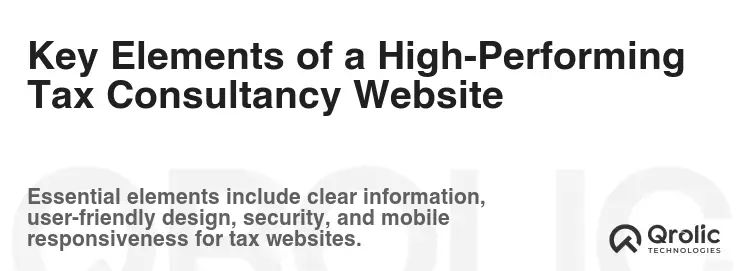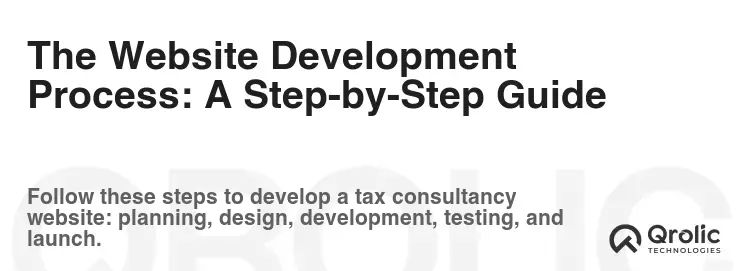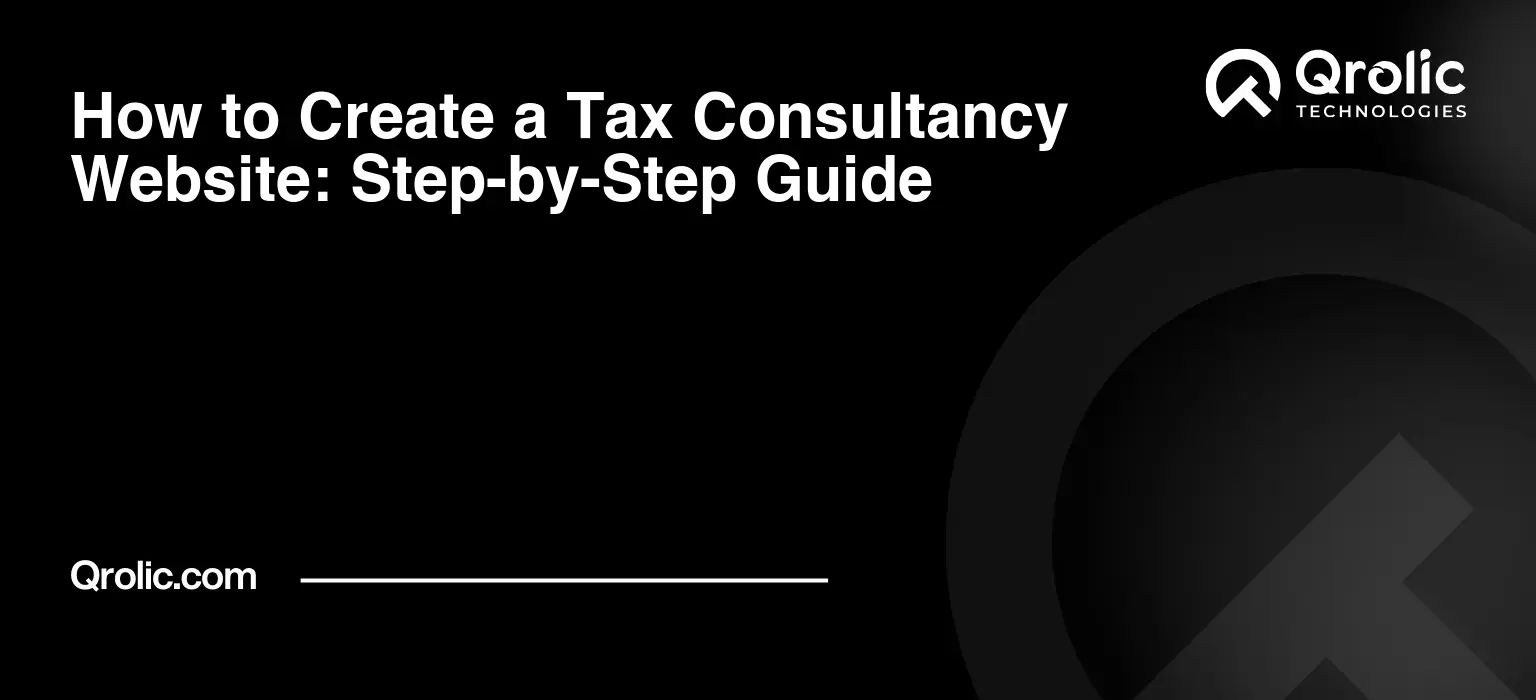Quick Summary:
- Your website is crucial for attracting tax clients.
- Good design, content, and SEO are essential elements.
- Always ensure your website is secure and up-to-date.
- Choose experts for development and ongoing support.
Table of Contents
- Why Your Tax Consultancy Needs a Stellar Website
- The Power of First Impressions in the Tax World
- Beyond the Brochure: A Website as a Client Acquisition Engine
- The Cost of Neglecting Your Online Presence
- Key Elements of a High-Performing Tax Consultancy Website
- 1. Professional Design & User Experience (UX)
- 2. Compelling Content: Expertise on Display
- 3. Search Engine Optimization (SEO)
- 4. Calls to Action (CTAs) and Lead Generation
- 5. Security and Trust Signals
- The Website Development Process: A Step-by-Step Guide
- Choosing the Right Website Development Partner
- Qrolic Technologies: Your Partner in Tax Consultancy Website Development
- Ongoing Maintenance and Optimization: Keeping Your Website Fresh
Why Your Tax Consultancy Needs a Stellar Website

In today’s digital age, your website is often the first impression you make on potential clients. For tax consultancy firms, a professional, informative, and user-friendly website isn’t just a nice-to-have; it’s a critical component of business success. Think of it as your 24/7 marketing powerhouse, a virtual office always open to welcome and assist clients.
The Power of First Impressions in the Tax World
Let’s face it: dealing with taxes can be stressful. Clients are looking for trust, expertise, and reliability. A poorly designed or outdated website can immediately undermine those crucial elements. A sleek, modern, and secure website, on the other hand, conveys competence and professionalism, instantly building confidence and attracting the right clientele. It’s the difference between appearing like a fly-by-night operation and a trusted, established firm.
Beyond the Brochure: A Website as a Client Acquisition Engine
Your website is more than just an online brochure. It’s a lead generation machine, a client engagement platform, and a brand-building tool all rolled into one. It can:
- Attract qualified leads: By implementing smart SEO (Search Engine Optimization) strategies, you can attract potential clients actively searching for tax services online.
- Showcase your expertise: Share valuable insights, articles, and resources to establish yourself as a thought leader in the tax industry.
- Streamline communication: Offer online contact forms, live chat support, and appointment scheduling to simplify client interaction.
- Build credibility: Display client testimonials, case studies, and professional affiliations to demonstrate your track record of success.
- Provide 24/7 accessibility: Allow clients to access important information, download forms, and make payments at their convenience, any time of day.
The Cost of Neglecting Your Online Presence
Think of your website as an investment, not an expense. Neglecting your online presence can lead to:
- Lost clients: Potential clients will likely choose a competitor with a more professional and informative website.
- Damaged reputation: An outdated or poorly designed website can damage your firm’s credibility and make you appear less trustworthy.
- Missed opportunities: You’ll miss out on valuable lead generation and client acquisition opportunities.
- Reduced efficiency: Without online self-service options, your staff will spend more time answering basic questions and handling routine tasks.
Key Elements of a High-Performing Tax Consultancy Website

Now that you understand why a great website is crucial, let’s dive into what makes a tax consultancy website truly effective. These are the essential elements you need to consider:
1. Professional Design & User Experience (UX)
Clean and Modern Aesthetics:
- Avoid clutter and overwhelming designs. Opt for a clean, modern, and professional aesthetic that reflects your firm’s brand.
- Use high-quality images and graphics to enhance visual appeal.
- Ensure your website is visually consistent across all devices and browsers.
Intuitive Navigation:
- Make it easy for visitors to find what they’re looking for.
- Implement clear and concise navigation menus.
- Use breadcrumb navigation to help users understand their location within the website.
- Include a prominent search bar for quick access to specific information.
Mobile-Friendliness (Responsive Design):
- Ensure your website is fully responsive and adapts seamlessly to different screen sizes and devices (desktops, laptops, tablets, smartphones).
- Mobile optimization is crucial, as many potential clients will access your website on their phones.
- Google prioritizes mobile-friendly websites in its search rankings.
Fast Loading Speed:
- Optimize images and code to ensure your website loads quickly.
- Use a reliable hosting provider.
- slow loading times can frustrate visitors and increase bounce rates.
Accessibility:
- Design your website with accessibility in mind, following WCAG (Web Content Accessibility Guidelines) principles.
- Ensure your website is usable by people with disabilities, including those with visual, auditory, motor, or cognitive impairments.
- Provide alternative text for images, use appropriate color contrast, and ensure keyboard navigation.
2. Compelling Content: Expertise on Display
Clear and Concise Language:
- Avoid jargon and technical terms that clients may not understand.
- Use clear, concise language that is easy to read and understand.
- Focus on the benefits you can provide to clients, rather than just listing your services.
Service Pages That Sell:
- Create dedicated pages for each of your core services (e.g., tax preparation, tax planning, audit assistance, business tax services).
- Clearly explain the benefits of each service and how it can help clients.
- Include case studies or testimonials to demonstrate your success.
Blog/Resource Section:
- Create a blog or resource section to share valuable tax-related information with your audience.
- Write articles, guides, and FAQs on topics such as tax deductions, tax credits, tax planning strategies, and changes in tax laws.
- This will establish you as a thought leader in the industry and attract organic traffic to your website.
About Us Page:
- Tell your story and introduce your team.
- Highlight your firm’s experience, expertise, and values.
- Build trust and rapport with potential clients by showcasing the people behind the business.
FAQ Section:
- Answer frequently asked questions to address common concerns and save time.
- Cover topics such as pricing, payment options, document requirements, and confidentiality.
3. Search Engine Optimization (SEO)
Keyword Research:
- Identify the keywords that your target audience is using to search for tax services online.
- Use keyword research tools like Google Keyword Planner, Ahrefs, or SEMrush.
- Focus on both broad keywords (e.g., “tax preparation services”) and long-tail keywords (e.g., “tax preparation services for small businesses in [city]”).
On-Page Optimization:
- Optimize your website’s content, meta descriptions, and title tags for your target keywords.
- Use keywords naturally throughout your content.
- Ensure your website has a clear and logical structure.
- Use header tags (H1, H2, H3) to organize your content and improve readability.
- Optimize images with alt tags that include relevant keywords.
Off-Page Optimization:
- Build high-quality backlinks from other reputable websites in your industry.
- Participate in online forums and communities to establish your expertise and build relationships.
- Create and share valuable content that people will want to link to.
Local SEO:
- Optimize your website for local search by including your business name, address, and phone number (NAP) on every page.
- Claim and optimize your Google My Business listing.
- Encourage clients to leave reviews on Google and other review sites.
- Target local keywords in your content (e.g., “tax accountant in [city]”).
4. Calls to Action (CTAs) and Lead Generation
Strategic Placement:
- Place clear and compelling CTAs throughout your website to encourage visitors to take action.
- Examples of CTAs include “Schedule a Consultation,” “Get a Free Quote,” “Download Our Tax Guide,” or “Contact Us Today.”
- Position CTAs prominently on your homepage, service pages, and blog posts.
Contact Forms:
- Make it easy for visitors to contact you by including a contact form on your website.
- Keep the form concise and only ask for essential information.
- Ensure the form is secure and protects user data.
Live Chat:
- Consider adding live chat support to your website to provide instant assistance to visitors.
- Live chat can help you answer questions, address concerns, and convert leads into clients.
Lead Magnets:
- Offer valuable resources, such as e-books, checklists, or templates, in exchange for visitors’ contact information.
- This is a great way to build your email list and nurture leads.
5. Security and Trust Signals
SSL Certificate:
- Install an SSL certificate to encrypt data transmitted between your website and visitors.
- This will ensure the security of sensitive information, such as financial data and personal details.
- Look for the padlock icon in the address bar to confirm that your website is secure.
Privacy Policy:
- Create a clear and comprehensive privacy policy that explains how you collect, use, and protect user data.
- Comply with relevant data privacy regulations, such as GDPR and CCPA.
Terms of Service:
- Develop terms of service that outline the rules and regulations for using your website.
Professional Affiliations:
- Display logos and badges of professional organizations and certifications to build credibility and trust.
- Examples include AICPA, state CPA societies, and IRS credentials.
Testimonials and Case Studies:
- Showcase positive client testimonials and case studies to demonstrate your expertise and track record of success.
- Real-world examples can be incredibly persuasive.
The Website Development Process: A Step-by-Step Guide

Developing a high-performing website for your tax consultancy firm requires a strategic and well-defined process. Here’s a step-by-step guide to help you navigate the process:
1. Planning & Strategy:
- Define your goals: What do you want to achieve with your website? (e.g., generate leads, increase brand awareness, improve client communication)
- Identify your target audience: Who are you trying to reach? (e.g., small business owners, individuals with complex tax situations)
- Conduct competitor analysis: Research your competitors’ websites to identify what they’re doing well and where they’re falling short.
- Develop a sitemap: Plan the structure and organization of your website.
- Create a content outline: Determine the content you’ll need for each page of your website.
- Set a budget: Determine how much you’re willing to spend on website development.
2. Design & Development:
- Choose a domain name: Select a domain name that is relevant to your business and easy to remember.
- Select a hosting provider: Choose a reliable hosting provider that can handle your website’s traffic and storage needs.
- Design the website layout: Create a visually appealing and user-friendly website layout.
- Develop the website: Code the website based on the design.
- Ensure responsiveness: Make sure your website is responsive and adapts to different screen sizes.
3. Content Creation:
- Write compelling content: Create engaging and informative content for each page of your website.
- Optimize for SEO: Optimize your content for search engines by using relevant keywords.
- Use high-quality images: Use professional-looking images to enhance your website’s visual appeal.
4. Testing & Launch:
- Test your website: Thoroughly test your website to ensure that all features are working properly.
- Check for errors: Fix any errors or bugs that you find.
- Optimize for speed: Optimize your website for speed to ensure a smooth user experience.
- Launch your website: Deploy your website to your hosting provider and make it live.
5. Maintenance & Marketing:
- Monitor your website: Regularly monitor your website for performance issues and security threats.
- Update your content: Keep your website content fresh and up-to-date.
- Promote your website: Market your website through various channels, such as social media, email marketing, and search engine optimization.
- Analyze your results: Track your website’s performance and make adjustments as needed.
Choosing the Right Website Development Partner

Selecting the right website development partner is a crucial decision that can significantly impact the success of your online presence. Here’s what to look for:
- Experience in the tax industry: Choose a partner with experience developing websites for tax consultancy firms.
- Strong portfolio: Review their portfolio to see examples of their previous work.
- Technical expertise: Ensure they have the technical skills to develop a high-performing website.
- Understanding of SEO: Choose a partner who understands the importance of SEO and can optimize your website for search engines.
- Communication skills: Look for a partner who communicates clearly and responsively.
- Project management skills: Ensure they have a well-defined project management process.
- Pricing transparency: Get a clear and transparent pricing quote.
Qrolic Technologies: Your Partner in Tax Consultancy Website Development

At Qrolic Technologies (https://qrolic.com/), we understand the unique needs of tax consultancy firms. We specialize in crafting websites that are not only visually appealing and user-friendly but also strategically designed to attract, engage, and convert potential clients.
Why Choose Qrolic?
- Industry Expertise: We have a proven track record of developing successful websites for tax professionals.
- Custom Solutions: We tailor our solutions to your specific needs and goals.
- SEO Focus: We prioritize SEO to ensure your website ranks well in search results.
- Mobile-First Approach: We develop responsive websites that look great on all devices.
- Ongoing Support: We provide ongoing support and maintenance to keep your website running smoothly.
Our Services Include:
- Website Design & Development: Custom website design and development that reflects your brand and values.
- Content Creation: Compelling and informative content that showcases your expertise.
- SEO Optimization: Strategies to improve your website’s visibility in search results.
- Website Maintenance: Ongoing support to keep your website secure and up-to-date.
- Digital Marketing: Comprehensive digital marketing services to help you reach your target audience.
Let Qrolic Technologies help you create a website that drives business growth and establishes your firm as a leader in the tax industry. Contact us today for a free consultation!
Ongoing Maintenance and Optimization: Keeping Your Website Fresh

Your website isn’t a “set it and forget it” project. It requires ongoing maintenance and optimization to ensure it continues to perform at its best.
Regular Content Updates:
- Keep your website content fresh and up-to-date with the latest tax laws and regulations.
- Add new blog posts, articles, and resources to keep your audience engaged.
- Update your service pages to reflect any changes in your offerings.
Security Updates:
- Install security updates regularly to protect your website from vulnerabilities.
- Use strong passwords and enable two-factor authentication.
- Monitor your website for suspicious activity.
Performance Monitoring:
- Track your website’s performance using tools like Google Analytics.
- Monitor metrics such as traffic, bounce rate, and conversion rate.
- Identify areas where you can improve your website’s performance.
SEO Monitoring:
- Track your website’s search engine rankings.
- Monitor your website’s backlinks.
- Adjust your SEO strategy as needed.
Staying Ahead of the Curve:
- Keep up-to-date with the latest website design and development trends.
- Implement new technologies and features to improve your website’s user experience.
- Continuously test and optimize your website to maximize its performance.
By following these tips, you can ensure that your tax consultancy website remains a valuable asset for your business. It’s about establishing trust, providing value, and making it incredibly easy for potential clients to choose you. A well-developed and maintained website is an investment that pays dividends in client acquisition, brand reputation, and overall business success.







